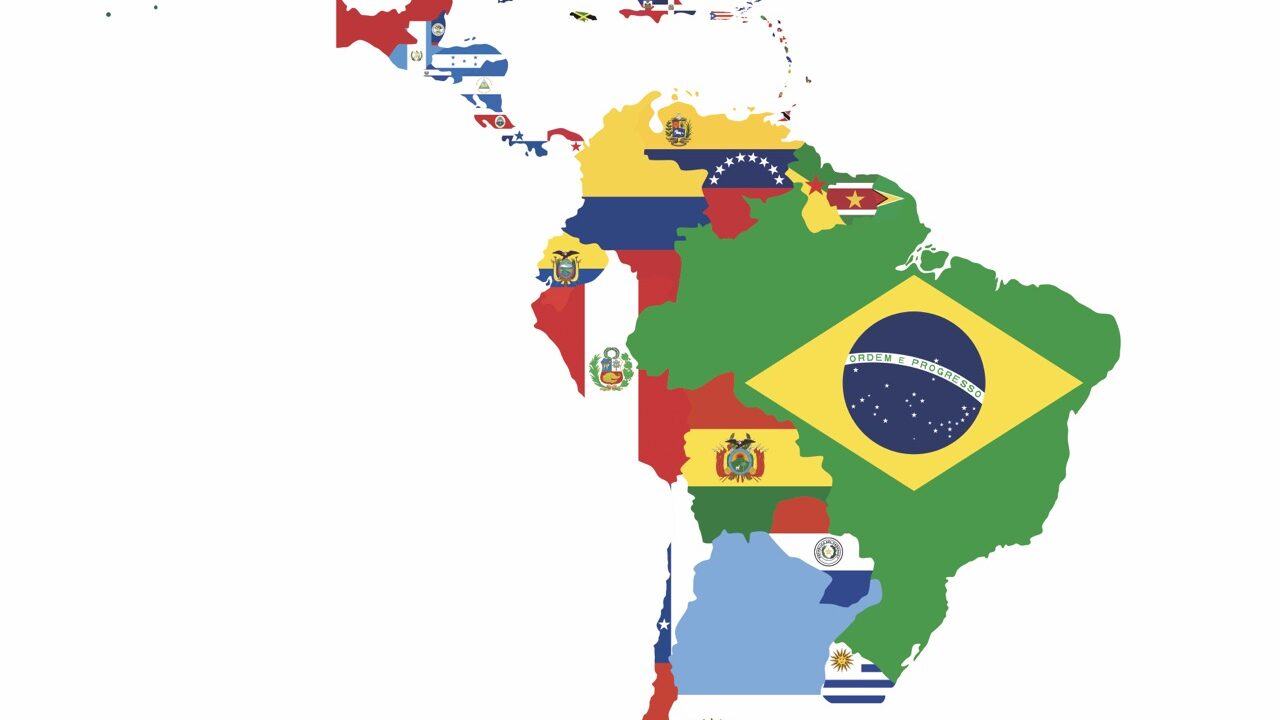Looking into broadcast in LatAm

Posted on Aug 14, 2025 by FEED Staff
Covering two hemispheres and comprising 33 countries, LatAm’s broadcast evolution could be at an inflection point
Words Neal Romanek
When we ask ourselves about the latest in broadcast, our first reflex is to think about the big US networks, the European stalwarts underpinned by powerful public broadcasters or the big streamers and tech companies hailing from California. Occasionally, we’ll even think about Asia – Japan’s NHK or China’s CCTV. What all these have in common is a location above the equator. Northerners forget that there’s a whole broadcast world just over the horizon.
Latin America stretches from Mexico in the north to Chile’s Cape Horn in the south, across 33 countries where the language is primarily Spanish, Portuguese (Brazil) and, in a few cases, French. There is no other region on Earth with so many countries in it bound by a common language, and yet Latin America is also home to over 500 different indigenous languages. The Latin American media sector is a mantle of shared communication over vast differences in geography, culture, technology and access.
Pristine production
Vivaro Video is a top technical provider for live broadcast in Latin America. Headquartered in Santiago, Chile, the company’s customers include broadcasters from the southern tip of Chile, all the way to Mexico. Starting as a camera rental and OB company, Vivaro’s service expanded further during the pandemic when broadcasters had to scale back the practice of doing all their tech provisions in-house and outsource to third-party providers.
“Just as in the rest of the world,” begins Vivaro director of technology and operations Gonzalo Jara, “there was an acceleration towards cloud technologies during the pandemic – first for production directly in the cloud, and then for remote productions. Since then, we’ve been doing production from our main hub in Chile for events all throughout Latin America.”
The Iberian languages that dominate the region simplify remote production in a way that would make for considerably more friction in a multi-lingual region like Europe. Vivaro recently, for example, produced a show remotely from its Santiago hub of a Major League Rugby match, which took place in Miami, Florida – a city with a strong Spanish-speaking population.
The match was captured entirely by local Miami production teams, with live commentary offered by a remote studio in Buenos Aires, Argentina, which was then delivered to Disney’s ESPN Latin America.
Brazilian Portuguese poses little barrier to this international, continent-spanning production ecosystem. Vivaro completed remote productions of a European football semi-final between Inter Milan and Paris Saint Germain just recently, controlled from its Chile HQ for Vivaro’s customer in Brazil.
“One of the advantages we have throughout the region is a lot of technical skill, as well as people who can speak the multiple languages to bridge that gap,” says Jara.
Slow and steady
Frequent large-scale technology upgrades, like those seen at organisations such as the BBC or CNN, are the exception rather than the norm globally. This is well exemplified in Latin America, where technology spends among broadcasters are intermittent and ad hoc. This is mostly the result of financial constraints – the majority of Latin America broadcasters are not going to get the same injections of cash that a European public broadcaster is used to. As result, there aren’t the clear switchovers from SD to HD or SDI to IP that are a familiar pattern in the north.
“Technology transitions are done over a long time, one format to another,” says Jason Barden, sales director for Latin America and the Caribbean at Riedel. “You end up with a mix of not just today’s and tomorrow’s technology, but past technologies too.”
Known for its live communication systems, Riedel provides solutions that can be inserted into any point in a broadcaster’s evolution, allowing them to make the most of what they have for as long as possible.
“In Latin America, you don’t just throw everything out and upgrade to something new,” Barden continues. “You end up changing things piece by piece – cameras this year, master control next year. They ultimately have to be creative, make the most of the owned assets and implement new solutions that will help tie everything together.”
Another challenge is that there isn’t always the same uniformity of tech standards across the region. This can require extra mindfulness from companies providing physical gear.
“While countries may share the same language, they have very different politics, which means different rules when it comes to import, export and tariffs – down to voltages and power cords. As a manufacturer, we need to be aware of all the various rules for all the different countries.”
Rethinking reporting
The traditional news and information sphere has undergone a gradual collapse over the last decade or more. It’s a global issue – and Latin America has been no exception.
“The reduction of advertising revenue really hit news broadcasters hard, forcing them to rethink the way they do the news, especially local news broadcasts,” highlights Jara. “In the case of Chile, for example, all of the private broadcasters have had to centralise their news production in Santiago, and the only broadcaster left doing local news production for smaller cities is that state broadcaster of Chile.”
Riedel’s Barden tells us a similar tale: “I’m based in Mexico, and the trend here has been centralisation. The top three broadcasters in Mexico have all massively reduced their local news production, cutting the smaller cities. Even my town, which has a million people, has lost some of its local news broadcasters.”
But this centralisation of news production does push newsrooms to present stories in ever more engaging ways. The stakes are higher, and tech integrations are made with audience impact in mind.
Broadcast graphics company Vizrt recently worked with a broadcaster in Panama to implement the company’s Viz Engine 5 to boost its newsroom with a new real-time graphics set-up. A key component of the new graphics set-up was the ability to incorporate augmented reality into broadcasts for a richer storytelling experience. Today, storytelling alone is rarely enough to keep eyeballs on a broadcast.
“Each Latin American country is navigating digital transformation at its own rhythm,” says Paula Brecci, senior channel sales manager at Vizrt, which is also located in Chile. “Compared to Europe or North America, we still see infrastructure limitations, tighter budgets and some regulatory hurdles. But what makes our region stand out is how adaptable and creative our broadcasters are.
“We’re seeing them embrace hybrid workflows and cloud-based tools to overcome these challenges. Since the pandemic, interest in cloud-native solutions has grown; broadcasters are beginning to realise that they don’t need massive physical infrastructure to deliver high-quality content any more.”
Connectivity and cloud
While there are large swathes of sparsely populated land throughout Latin America – especially in South America – there’s good connection across its major cities. Fully cloud-based production is starting to be adopted too, but broadcasters have avoided using it for major events. The evolution has been similar to that in other parts of the world, with cloud production reserved for smaller events or broadcasts going straight to streaming or social media platforms.
Some of the smaller markets outside major cities might not be able to support the connectivity and bandwidth required for a broadcast, though that’s changing too.
“IP and cloud workflows are no longer simply future concepts –they are becoming a reality across Latin America,” notes Vizrt’s Brecci. “While adoption may have started slower here, we’re now seeing an acceleration, especially in sports and live productions. Many broadcasters are taking a hybrid approach, combining existing infrastructure with cloud-native tools. It’s a smart way to transition without disruption.”
Additionally, the major cloud providers have made commitments to build several big data centres throughout the region. São Paulo, Brazil is already an enormous – and globally important – hub. Plus, it is a connecting point for many of the main cables linking South America with the rest of the world, but there are also hubs being built in Chile and Colombia. Just last year, Google announced plans for the construction of a monumentally big data centre in Canelones, Uruguay.
The Mexican state of Querétaro – already a home to Mexican data centres – has become a destination for the major cloud providers too, with AWS, Google and Microsoft pouring billions into their own data centre projects in the region, creating local friction around their effect on water supply in the region. The area will become one of the major hubs for all of Mexico and Central America. Jara says he believes that broadcasters are going to be looking for simpler, more flexible solutions to stay on top of what could be a dynamic growth period, and cloud will be key to that.
“Cloud will also be one of those important solutions that’s going to help broadcasters achieve production for new kinds of events and sports in the region. This could range from basketball to baseball – as well as some of the smaller football leagues.”
Developing distribution
This greater availability and reliability of cloud and IP infrastructure is set to change how content is distributed across the Americas. Globecast, for example, has been a primary global distributor (via satellite) for Latin American broadcasters. As these broadcasters have moved off satellite and over to IP, the company now offers a hybrid solution appropriate for the region these broadcasters are distributing into.
Satellite is still part of the Globecast toolkit for reaching into markets less penetrated by IP networks, but terrestrial fibre and tools such as the company’s GCXN service – which can deliver broadcast-quality content over the public internet – all form a hybrid solution which can adapt to Latin America’s wide variety of content delivery requirements.
Monitoring of customer experience becomes easier too. Latin American broadcasters can more easily monitor their signals in other regions, which are mirrored in Globecast’s new facility in Westlake Village, Los Angeles.
“If they need regional monitoring of customer experience – whether that’s via cable distribution, OTT or a digital platform – we can offer a view into that, allowing them to see exactly what the customer experience is,” says Neil Butterfield, sales director at Globecast.
“A lot of emerging social media platforms that are taking over content distribution have savvy IT departments, but they are not video-centric experts. When we identify problems internationally, sometimes it’s as simple as knowing an audio problem really isn’t downstream. It’s actually a mic problem happening at the venue. When you have someone at a help desk that’s an expert audio-video engineer, they’re able to identify those things, and they can do that from anywhere in the world.”
Butterfield notes the continuing allocation of the C-band spectrum to telecommunications companies for data and cellular telephony will further change content delivery in Latin America. This allocation is happening now in the US, but will be followed by Mexico, Brazil and then the other Latin American markets. A lot of the services that were on C-band satellite will need to migrate.
“Satellite has always been the reliable go-to technology,” he adds. “Content creators of different kinds – it’s not only the broadcasters any more – who need to reach multiple platforms via different technologies will get access through these more hybrid networks.”
The region seems like it’s set for dramatic growth over the next few years, particularly as it hits a critical mass of digital infrastructure.
“The future of broadcasting in Latin America is bright,” says Brecci. “We’re heading toward more agile, flexible and platform-independent workflows. Automation, AI, cloud production – these are no longer ‘nice to have’, they’re becoming essential. The talent in our region is incredible. With the right tools and support, broadcasters in Latin America are not just catching up – they’re ready to lead.”
This article first featured in the Summer 2025 issue of FEED magazine.









